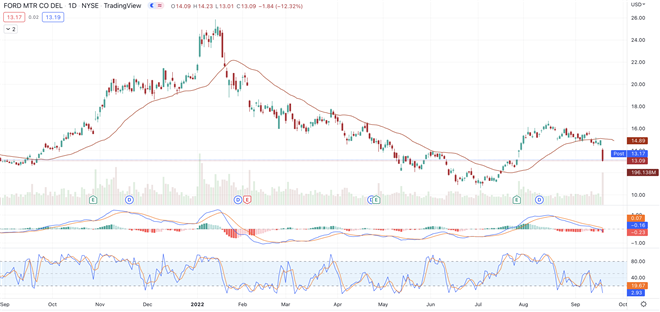 Ford (NYSE: F) may be in “buy the dip” mode, judging by its year-to-date decline of 38.42%.
Ford (NYSE: F) may be in “buy the dip” mode, judging by its year-to-date decline of 38.42%. Since rebounding from its July 5 session low of $10.61, the stock is up 18.66%. Does that mean the stock has bottomed and it’s time to jump back into the driver’s seat?
Not so fast.
Even if a stock appears to be in rally mode, it’s wise to consider other factors that may affect your return, particularly if you’re considering a swing trade rather than a long-term hold.
For starters, if you’re eyeing a company, check whether it’s reporting earnings soon. Ford is slated to deliver second-quarter results on July 27.
According to MarketBeat earnings data, Wall Street expects Ford to earn $0.44 per share. Revenue is seen coming in at $34.29 billion. Both represent growth over the year-ago quarter.
Ford missed earnings estimates in the past two quarters. In addition, earnings slowed in the past three quarters, on a year-over-year basis.
Traditional rival General Motors (NYSE: GM) also suffered earnings slowdowns, while more trendy Tesla (NASDAQ: TSLA) has been growing income at triple-digit rates in the past five quarters. Tesla’s revenue grew between 39% and 98% in each of the past seven quarters.
Does that disparity suggest that Ford and General Motors are doomed to lag Tesla’s all-electric vehicle strategy?
Revving Up The F-150 Engine
Ford management hasn’t fallen asleep at the wheel. The company is rolling out the 2023 Ford F-150 Raptor R, a pickup truck that boasts a 700 horsepower engine. Ford fanboys and girls will pay a hefty price for that, with the pickup carrying a minimum list price of $109,145. While buyers have grown accustomed to pricey EVs, this fossil-fuel-powered vehicle is in a price class of its own.
Of course, it remains to be seen whether that price can attract enough buyers to make the product a hit, or whether it’s just a flashy marketing gimmick.
Not everything at Ford is speeding down the highway. The company is recalling 100,680 hybrid vehicles, including the Ford Escape, Lincoln Corsair and Ford Maverick, due to the potential for engine compartment fires.
Even so, the stock climbed 5.27% Tuesday in heavier-than-normal trading volume. That marked Ford’s third session in a row with gains.
Analysts’ consensus rating on Ford is a “hold,” with a price target of $17.94, a 42.53% upside over where the stock is currently trading. Remember, the price target itself should be viewed separately from the analyst rating. The price target can represent a longer-term view, meaning investors may have to wait 18 months before the stock reaches - or fails to reach - that target. A lot can happen in 18 months, including purchasing a stock that languishes, while incurring an opportunity cost from investment ideas you rejected.
For the year, Wall Street has pinned earnings at $1.92 per share, a 21% gain over 2021. Next year, that’s seen growing another 6%, to $2.03 per share.
Ford Vs. The S&P 500
So how does Ford power up, when compared to the broader market?
It’s lagging its index, the S&P 500, which is down 20.20% so far this year. In addition, the stock’s shorter-term moving averages, such as the 10-day, 21-day, and 50-day lines, are below the longer-term 200-day line. That’s been the case since April.
That type of weakness isn’t necessarily the best time to buy into a single stock, because you’re adding risk before the stock has proven it’s in a sustained rally. In addition, a broader market and industry-specific weakness can also drag down a stock, even if it seems like it’s beginning a rally.
On a brighter note, Ford closed above its 50-day line Tuesday, for the first time since January. In addition, the stock gapped up at the open and held its gains in each of the past three sessions.
Nonetheless, it’s always the case that a single stock carries greater risk than a basket of stocks, and if you’re going to make a purchase, it better be something you have a high degree of conviction about. 
